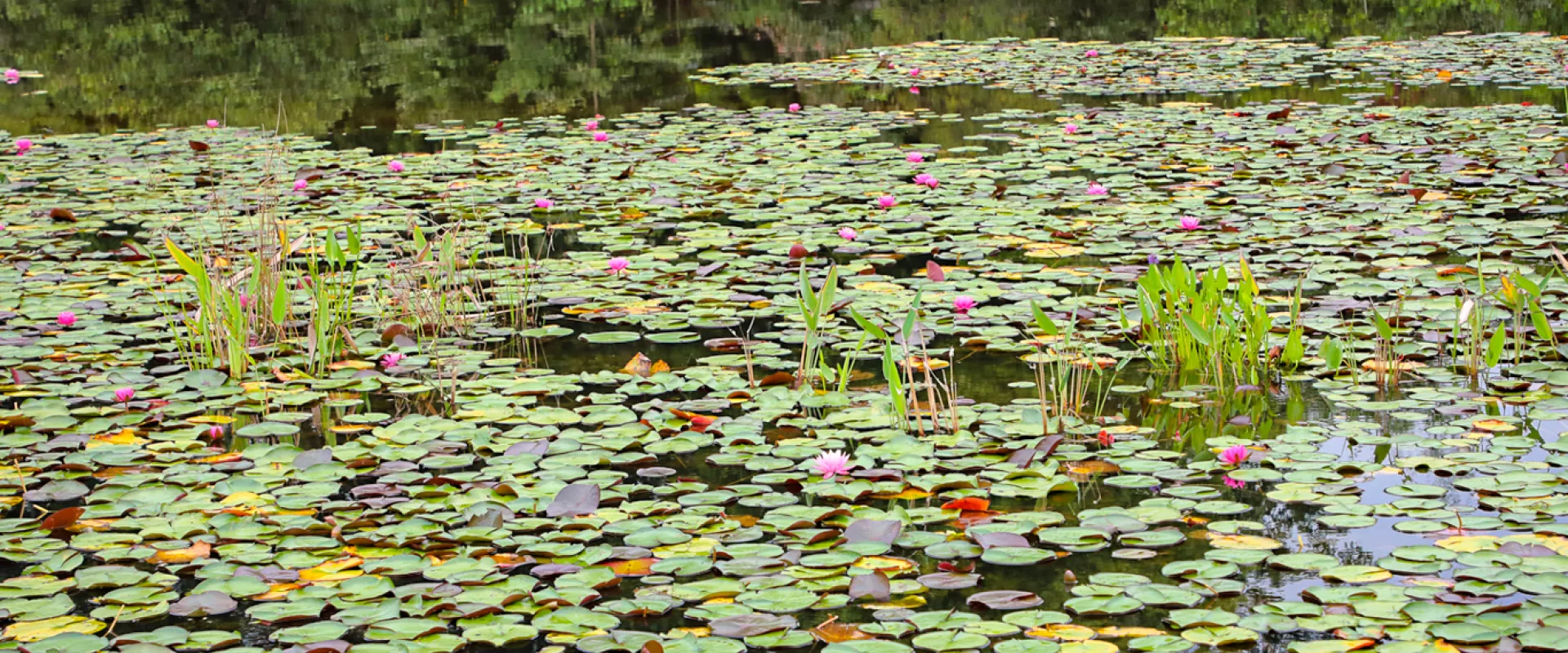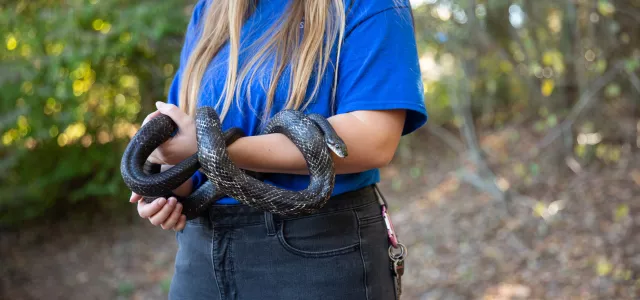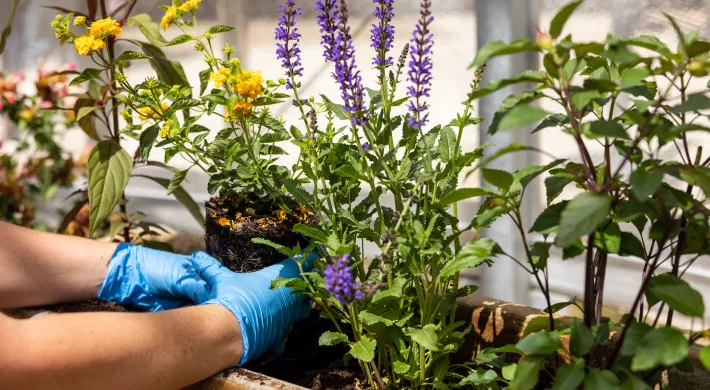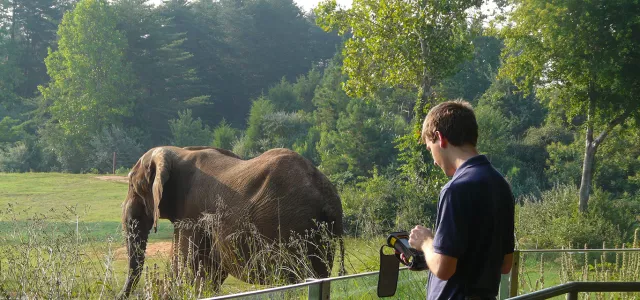The North Carolina Zoo is committed to sustainability. We work hard to reduce our impact on the environment and raise awareness about green practices you can use at home, too. On this page, you can learn about how the Zoo uses techniques like solar energy, composting, and recycling to reduce our impact on the natural world.
Caring About More than Animals
The North Carolina Zoo embraces our responsibility as caretakers of the Earth. Our concern for the natural environment starts at the Zoo, but also extends well beyond the animals living under our care.
For over 30 years, we have invested in natural resource conservation to maintain ecosystems and prevent environmental degradation. The Zoo is also a long-term member of North Carolina’s Environmental Stewardship Initiative. We are proud to hold the "Three Dogwood" designation with the NC Green Travel initiative as a green attraction business. This is the highest level and demonstrates our commitment to environmental stewardship.
Beginning with its first ‘green practices’ in the late 1980s, the Zoo has onboarded various sustainability projects. These include using high-efficiency LED lighting, improved HVAC control systems, extensive recycling and composting programs, and a comprehensive approach to minimizing single-use plastics throughout Zoo operations. Reducing plastic use helps accomplish numerous goals, including reducing the consumption of fossil fuels, eliminating potential marine debris, and addressing growing concerns over microplastic pollution.
Award-Winning Sustainability Program
In 2022, the World Association of Zoos and Aquariums (WAZA) honored the North Carolina Zoo with the top sustainability award.
The Zoo's Environmental Policy
“It is the policy of the North Carolina Zoo to conduct operations in an environmentally responsible and sustainable manner; to comply with environmental laws, regulations, and other requirements; to reduce the use of resources and generation of waste; to strive for continual improvement; and to lead by example.”
G Growth in knowledge and continual improvement
R Reduction in use of resources and waste
E Environmentally responsible and sustainable operation
E Environmental protection and pollution prevention
N Necessary compliance with environmental laws, regulations, and other requirements
Minimizing our impact
We have identified actions, materials, and processes that could negatively impact the environment. When left unmitigated, these impacts would ultimately result in increased costs for the citizens of North Carolina. To reduce the effects, all Zoo staff, volunteers, and contract staff are responsible for:
- Managing and conserving energy resources.
- Conserving motor vehicle fuel and using alternative fuels as possible.
- Minimizing solid waste through recycling/repurposing.
- Minimizing the use of harmful chemicals such as pesticides and harsh cleaners.
- Managing water use and wastewater disposal.
- Instituting policies to minimize construction waste and environmental disturbance; assuring that stormwater runoff does not contain chemicals, pathogens, or excess silt.
- Innovative use of resources that repurpose durable materials and recycle as much waste as possible.
- Protecting atmospheric quality. Motor vehicles, HVAC systems, and cooking equipment receive regular maintenance.
What is the “Green Team?"
The North Carolina Zoo’s has a team of passionate professionals who make ongoing improvements to our sustainability program. This Green Team conducts informational lunch events for staff and volunteers, coordinates the Earth Day Celebration each April, works to keep staff informed about proper procedures for recycling, conducts Adopt-A-Highway cleanups yearly, and hosts the annual “Use Less Stuff Sale” each November to promote the idea of “reuse before refuse!”
Recycling since 1989
Since 1989, the Zoo has engaged in paper-conserving measures. (Way back in 1989, very few staff had regular computer access!) At that time, the Zoo relied on paper photocopies to distribute information to staff members, and a significant amount of paper was used. One early goal was to encourage copying on both sides of the paper. Even today, our printers have double-sided printing as the default setting. Today, this simple practice is an ingrained habit.
Minimizing HVAC energy use
The heating, ventilation, and air conditioning (HVAC) of Zoo buildings can consume a significant amount of energy. Using an efficient centralized control system with standard temperature settings reduced energy costs by 25% the first year the system was in place at the Zoo's main office building.
Monitoring energy use
One of our best tools to detect energy inefficiencies has been installing electric meters in buildings at the Zoo. Each month, our staff compares power consumption with previous months and years. Power consumption anomalies help us spot problems with HVAC systems or lighting. Meters help maintenance staff proactively initiate repairs before a system breaks down.
Large-scale composting
The Zoo’s elephant herd is responsible for a ton (2,000 pounds) of manure daily. Add in waste from the rhinoceroses, antelope, zebra, giraffe, elk, and bison; you can imagine one large manure pile! Disposal is problematic and expensive since discarding this material in landfills is unacceptable. Hauling this waste away from the Zoo would degrade the air and increase fuel consumption.
During the 1980s, our Horticulture section began a small-scale composting operation. Initially, we only composted plant and grass clippings associated with maintaining Zoo grounds. As we added the North America section, it was clear that the compost operation needed to expand, not only to process more plant material but also to allow the addition of manure to the mix. In 1996, we received permission from North Carolina to develop a 2-acre site to handle our growing composting needs.
Today, we process about 2,000 tons of manure and plant waste annually on this site, surfaced with repurposed fly ash from a nearby coal power plant. "Windrows" (a line of heaped material) take about three months to turn from manure and clippings into nutrient-rich compost. Bacteria and germs in manure do not survive the composting process, which creates high heat. We ensure this by sending a sample from each windrow to North Carolina State University for testing. Rainwater is captured in a retaining basin and pumped into the sanitary sewer. That water goes through the City of Asheboro’s treatment plant.
All of the compost generated here stays here, too. We use every bit in our horticulture operations, saving money.
The most recent development in compost and waste reduction has been adopted by Service Systems Associates (SSA) our food service contractor. In 2017, SSA initiated a project to compost all the food scraps associated with the Zoo’s meal preparation activities. Staff collects these materials from the five restaurants and transports them to the compost area. SSA has gone even further by eliminating most single-use, disposable plastics used on the Zoo’s grounds. This is one reason you will not be able to get a straw at the Zoo, and that all beverage cups are compostable or refillable souvenir cups. All spoons, knives, and forks distributed at the Zoo are plant-based, compostable plastic. Plates and bowls are also fully compostable plant fiber. Our popcorn bags may look like plastic, but are a compostable clear material!
LED efficient lighting
In November 2015, the Zoo converted all lighting in our primary Auditorium to energy-efficient LED lighting. The original bulbs consumed over 14,000 watts of power to light the room. Replacing those light fixtures with 20 LED lights gave = the room the same light but only required about 500 watts of power—almost 30 times less energy.
Water Ways
The North Carolina Zoo uses about 40 million gallons of potable drinking water annually. Almost every Zoo operation requires water, from restrooms to the veterinary hospital. We have taken several steps to reduce water usage. For example, several meters keep track of the incoming potable water; this helps to isolate leaking pipes or a restroom with bad toilet valves.
Special meters were installed to enable our water supplier, the City of Asheboro Water Resources, to understand the Zoo's water disposal needs better. Much of the Zoo's incoming water is used for animals to drink and plant irrigation and never goes into a drain. To better understand our water needs and manage our sewer costs, we have installed meters on our outgoing sewer line. These meters show that only about 60% of the water we buy goes into the treatment system. Our relationship with the City of Asheboro Water Resources enables us to pay the actual costs of our water usage rather than the estimated costs for sewage disposal and treatment. These measures also benefit the City of Asheboro Water Resources, which can better plan for the area’s water disposal needs.
Natural Filtration
Some cars in the North America parking area will have small leaks of oil, antifreeze, or brake fluid. Rain washes these chemicals into the Zoo’s lakes, harming our area’s aquatic life and reducing water quality.
However, nature can neutralize these chemicals, keeping them from harming insects, fish, and amphibians living downstream, but it takes time. In 2010, the Zoo built a constructed wetland adjacent to the Dragonfly Pointe picnic area to reduce the harm of these chemicals on our natural world. This wetland can filter a one-inch rain event every seven days. During this filtration process, water-based chemicals dilute so they do less harm. Fungi and bacteria break these diluted chemicals down, rendering them harmless before entering the lake. To make the process more effective, plants maintained around the wetland slow the flow of water, so heavier chemicals settle to the bottom, where aquatic organisms break those down over a longer period.
Xeriscaping
Xeriscaping is using native plants that tolerate local weather and soil conditions. It also uses drought-tolerant plants, allowing attractive gardens that do not require excessive irrigation systems.
When water levels are appropriate, the Zoo takes water from either the North America or the Africa lake for irrigation. This decreases costs and places less of a demand on local water resources. We have also become partners with the Rain Bird Corporation and have installed state-of-the-art monitoring systems that tell our horticulture supervisors when and how long we should turn on the sprinklers on any given day. Readings reflect detected temperatures, relative atmospheric humidity, rain potential, and ground moisture. By implementing this system, we can provide proper water for the plants without over-watering or wasting resources.
Integrated Pest Management
Integrated Pest Management (IPM) is one way the Zoo minimizes its use of potentially toxic pesticides. For example, to prevent flies at the compost site from becoming problematic, a biocontrol was introduced in the form of a small wasp that preys upon fly eggs and larvae. These wasps do not sting. Biocontrols are also used in our indoor habitats, where predatory insects eat plant-damaging bugs. There are times when stronger measures are needed to control a plant or insect pest for which biocontrols are not effective. Training and certification by the NC Department of Agriculture ensure that staff do not allow harmful chemicals to wash into lakes, ponds, and creeks on and around the Zoo property.
Solar Pointe
Solar Pointe is a collection of three picnic shelters near the North America parking lot. Each pavilion rooftop has 3,200 square feet of photovoltaic panels that can generate 104 kilowatts of power per hour. These panels supply energy to the local power grid through our partnerships with Carolina Solar Electric Company and the Randolph Electric Membership Cooperative. Though 104 kilowatts is not a huge amount of electricity, this supply helps reduce the local demand for energy on hot and cold days when local homes need it for cooling and heating.
Act Local
The Zoo has a substantial role in local initiatives to protect wildlife and wild places. A team of Zoo staff functions as the “Arctic Ambassador Center” (AAC) to promote activities that can help mitigate the effects of atmospheric carbon. The AAC takes the lead on tree planting projects with our “Acres for the Atmosphere” plantings. Over 400 trees planted on public and semipublic lands provide shade, reduce demand for energy to cool facilities, and serve as a carbon sink. The Arctic Ambassadors also recognize local and regional businesses with the “Paw of Approval.” This recognition acknowledges businesses that are working to institute green practices and become models of environmental sustainability.
Since 2004, the Zoo has coordinated and led local efforts to reduce aquatic litter as part of the International Coastal Cleanup. Though the Zoo is not near the coast, both river basins in Randolph County lead directly to the ocean. Litter can harm freshwater-dependent animals, too, including turtles, fish, amphibians, birds, and mammals. In 2016, the North Carolina Zoo became the only Zoo in the country to host a Keep America Beautiful Affiliation on behalf of the County. Through this affiliation, the Zoo works with schools, civic groups, and other citizens to provide grassroots-level education and conservation initiatives that protect water and air resources through litter reduction, improved recycling efforts, and community beautification projects.
Alternative Fuels
Each year, the North Carolina Zoo hosts over a million guests. Moving guests from place to place can be difficult and use a lot of petroleum fuel. The Zoo has been moving towards using more electric vehicles in our fleet.
Metal Recycling
The Zoo is like a small town with more than 700 total employees in the busy season. Many of our sections use significant amounts of metal. Steel and aluminum that is no longer useful ultimately go to the local recycling center.
Environmental Steewardship
The State of North Carolina, through the Department of Environmental Quality, developed the Environmental Stewardship Initiative (ESI). This is a voluntary, no-cost program designed to “promote and encourage superior environmental performance by North Carolina’s regulated Community.” ESI is a high profile way that the Zoo is an example of sustainability in our State. Our status as a Full Steward in this program signifies that we have developed and implemented our Environmental Management System, that we set and pursue aggressive goals in managing our potential impacts and that we exceed minimal levels of compliance with guidelines and regulations.
EV Charging Stations
In continuing efforts to maintain air quality and encourage new transportation technology, the Zoo provides guests with eight charging stations for electric vehicles. Four of these are located in North America parking lot “D," immediately in front of the Stedman Education Building. Four charging stations are also located next to the Solar Pointe picnic area in the North America parking area. Parking spots are marked for Electric Vehicles Only.
Sustainability Recognition
Our green practices and sustainability initiatives draw considerable attention locally, regionally, nationally, and globally!
1996 - The NC Recycling Association Award for Outstanding Source Reduction.
1999 - Governor's Outstanding Source Reduction Award.
2000 - The "Conservation Captains" received the Department of Environment and Natural Resources (DENR) Environmental Sustainability Award.
2001 - The Zoo's Compost Program was awarded the Carolina Recycling Association's Outstanding Compost Program Award.
2002 - The Zoo was certified under ISO 14001 for Environmental Management System.
2004 - State Government's NC Green Team awarded the Zoo the first State Government Sustainability Award.
2005 -The Zoo was recognized by the Department of Environment and Natural Resources (DENR) for The Cell Phone Recycling Program.
2005 - Sustainable NC awarded the Zoo the 2005 NC Sustainability Award for organization-wide sustainability efforts.
2006 -NC Big Sweep awarded the Zoo the Caroline Parker Outstanding Achievement Award.
2006 - The Department of Environment and Natural Resources Sustainability Team recognized the Zoo Biodiesel Program.
2006-The International Zoo Educators Association invited the Zoo to their international Conference in Pretoria, South Africa, where we presented details of our Green Practices Program to Educators from around the World
2007 - NC Land Trust recognized the Zoo as the State Government Conservation Partner of the Year.
2012-The Zoo became the inaugural recipient of the Association of Zoos and Aquariums Green Award, recognizing our efforts with Sustainability initiatives
2017-The NC Source Water Collaborative cited the Zoo with an Award of Excellence for efforts taken to protect Surface Water Quality
2022 - World Association of Zoos and Aquariums awards the Zoo top award for Sustainability.




